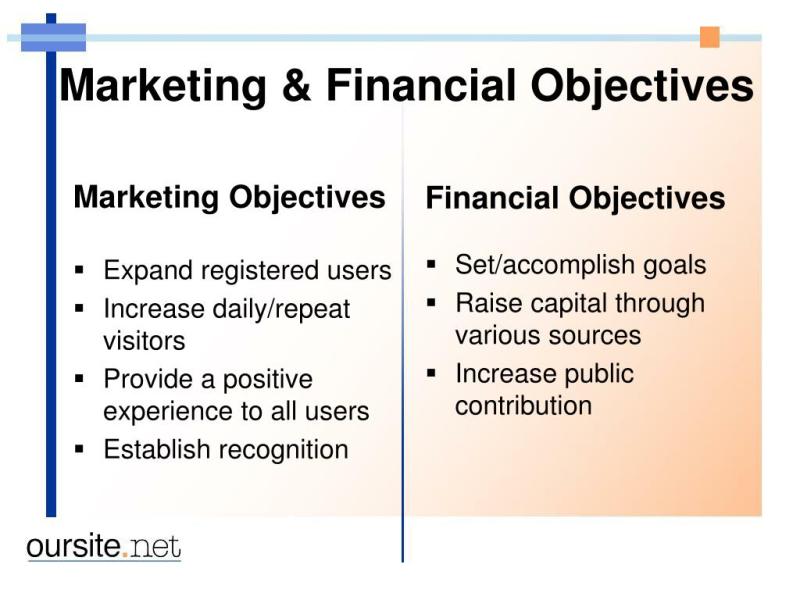What are strategic and financial objectives?
Strategic Objectives:Strategic objectives are high-level, overarching goals that an organization aims to achieve to fulfill its mission and vision. These objectives guide the long-term direction of the company and are often qualitative and focused on broader outcomes. They set the framework for decision-making and help the organization allocate resources and efforts toward achieving its desired future state.
Examples of strategic objectives might include:
- Expanding market share in a specific geographic region.
- Becoming a leader in innovation within the industry.
- Enhancing the organization's reputation and brand image.
- Improving customer satisfaction and loyalty.
- Diversifying product or service offerings.
Financial Objectives:Financial objectives, on the other hand, are specific, measurable, and time-bound targets related to the organization's financial performance. These objectives provide a quantitative framework for assessing the financial health of the company and its ability to support the achievement of strategic goals. Financial objectives are closely tied to the company's profitability, liquidity, solvency, and other key financial metrics.
Examples of financial objectives might include:
- Achieving a certain level of revenue growth (e.g., 10% increase in sales).
- Improving profit margins (e.g., increasing net profit margin by 5%).
- Managing working capital effectively to ensure liquidity.
- Reducing debt levels to improve the company's solvency.
- Enhancing return on investment (ROI) for specific projects.
Alignment and Importance:
Strategic Alignment:
- For optimal organizational performance, strategic and financial objectives should be aligned. Financial objectives should directly contribute to the achievement of strategic goals. For example, if a strategic objective is to expand market share, corresponding financial objectives might include increasing sales revenue and improving profitability in target markets.
Resource Allocation:
- Strategic objectives guide resource allocation decisions. Financial objectives help determine the financial resources required to support strategic initiatives. The allocation of funds to various projects and activities is done in a way that aligns with both strategic and financial objectives.
Performance Measurement:
- Financial objectives provide quantifiable metrics for assessing the performance of the organization. Regular monitoring of financial performance against objectives allows for adjustments and ensures that the company stays on track to achieve its strategic goals.
Decision-Making Framework:
- Both strategic and financial objectives create a decision-making framework. When faced with choices regarding investments, operational changes, or other initiatives, decision-makers can evaluate options based on their alignment with both sets of objectives.
Stakeholder Confidence:
- Aligning strategic and financial objectives enhances stakeholder confidence. Investors, shareholders, and other stakeholders are more likely to support an organization that not only has a clear strategic direction but also demonstrates a sound financial plan for achieving its objectives.
Long-Term Sustainability:
- The alignment of strategic and financial objectives contributes to the long-term sustainability of the organization. Financial stability supports the implementation of strategic initiatives, and successful strategic outcomes positively impact financial performance.
In summary, while strategic objectives define the direction and purpose of an organization, financial objectives provide the quantitative measures and financial targets necessary to support and achieve these strategic goals. The alignment of these two types of objectives is crucial for effective decision-making, resource allocation, and sustained organizational success.
Aligning Strategic and Financial Goals: Ensuring Financial Decisions Support Strategic Objectives
Achieving long-term organizational success requires a cohesive alignment between strategic and financial goals. Strategic goals define the organization's overall direction and aspirations, while financial goals provide the roadmap for achieving those aspirations through effective resource allocation and financial management.
Aligning strategic and financial goals involves:
Understanding the organization's strategic vision: Clearly articulate the organization's mission, vision, and values, which serve as the foundation for both strategic and financial planning.
Translating strategic goals into financial objectives: Convert strategic goals into measurable financial targets that align with the overall strategic direction.
Incorporating financial considerations into strategic planning: Integrate financial analysis and projections into the strategic planning process to ensure that strategic decisions are informed by financial feasibility and sustainability.
Ensuring financial decision-making supports strategic objectives: Evaluate all financial decisions in the context of their impact on achieving strategic goals, prioritizing resource allocation and investments that align with the organization's strategic direction.
Defining Strategic Objectives: Establishing Clear and Measurable Goals for the Organization
Strategic objectives provide the guiding principles for an organization's direction and aspirations. They should be clear, measurable, achievable, relevant, and time-bound (SMART).
Steps in defining strategic objectives:
Conduct a thorough assessment: Analyze the organization's current position, internal strengths and weaknesses, external opportunities and threats, and stakeholder expectations.
Establish clear goals: Articulate specific, measurable goals that align with the organization's mission and vision.
Set measurable targets: Define quantifiable targets for each strategic objective, allowing for progress tracking and evaluation.
Ensure achievable goals: Set realistic goals that are achievable within the organization's capabilities and resources.
Evaluate relevance: Verify that the strategic objectives are relevant to the organization's overall direction and address the identified opportunities and challenges.
Establish timeframes: Assign specific timelines for achieving each strategic objective, creating a sense of urgency and focus.
Developing Financial Objectives: Translating Strategic Goals into Financial Targets
Financial objectives provide the financial targets that will guide the organization's resource allocation and financial management to achieve its strategic goals.
Steps in developing financial objectives:
Identify financial implications: Analyze the financial implications of each strategic objective, considering the costs, revenue potential, and resource requirements.
Set financial targets: Translate strategic objectives into measurable financial targets, such as profitability targets, revenue growth targets, or cost reduction targets.
Align with strategic goals: Ensure that the financial objectives directly contribute to the achievement of the organization's strategic goals.
Consider financial constraints: Set financial targets that are realistic within the organization's financial capabilities and constraints.
Incorporate financial projections: Develop financial projections that demonstrate how the financial objectives will be achieved over time.
Establish performance metrics: Identify key financial metrics to track progress towards achieving financial objectives.












